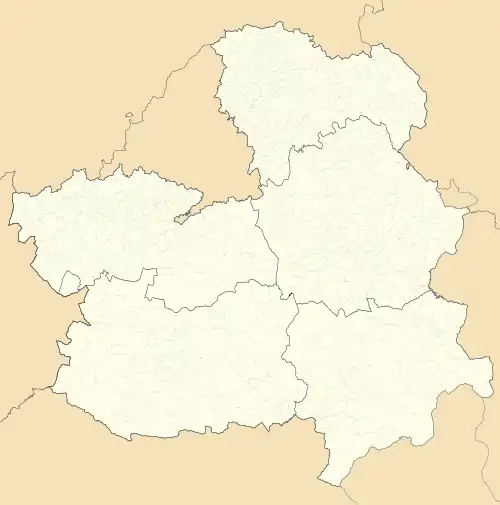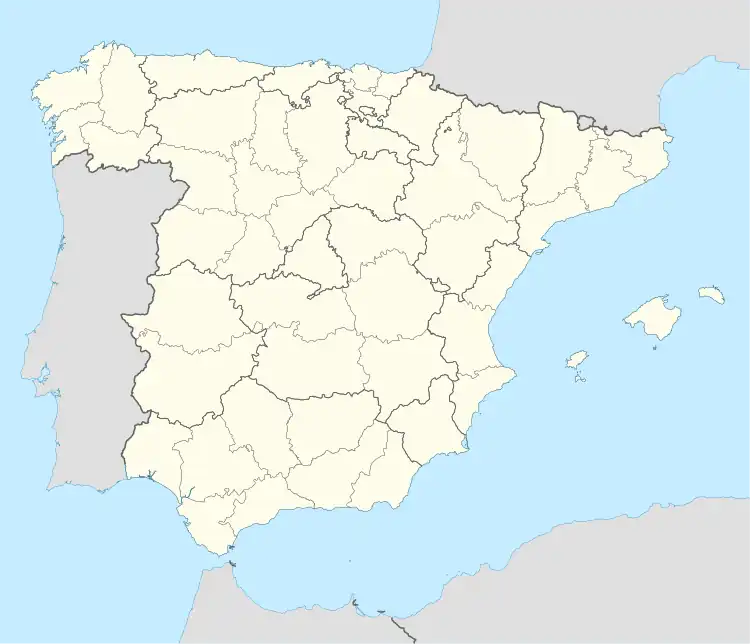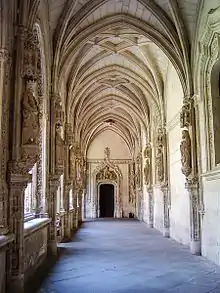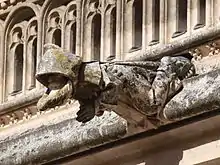 Monastery of San Juan de los Reyes | |
 Location within Castilla-La Mancha  Monastery of San Juan de los Reyes (Spain) | |
| Monastery information | |
|---|---|
| Other names | San Juan de la Reyna |
| Dedicated to | Saint John the Evangelist |
| People | |
| Founder(s) | King Ferdinand II of Aragon and Queen Isabella I of Castile |
| Architecture | |
| Architect | Juan Guas |
| Style | Isabelline |
| Groundbreaking | 1477 |
| Completion date | 1504 |
| Site | |
| Location | |
| Coordinates | 39°51′28″N 4°1′54″W / 39.85778°N 4.03167°W |

The Monastery of San Juan de los Reyes (English: Monastery of Saint John of the Monarchs) is an Isabelline style Franciscan monastery in Toledo, in Castile-La Mancha, Spain, built by the Catholic Monarchs (1477–1504).
A monument to celebrate
This monastery was founded by King Ferdinand II of Aragon and Queen Isabella I of Castile to commemorate both the birth of their son, Prince John, and their victory at the Battle of Toro (1476) over the army of Afonso V of Portugal.
Prince John of Portugal also celebrated[1] his victory over the Castilian army of the Catholic monarchs with a solemn procession on each anniversary of the battle.[2][3] This apparent contradiction was a consequence of the indecisive[4][5] military outcome of the battle: the troops under Afonso V broke[6][7] while the forces led by Prince John of Portugal defeated[8][9] the Castilian right wing and remained in possession of the battlefield.[10][11]
Undoubtedly, the battle represented a decisive political victory for the Catholic Monarchs,[12][13] assuring them the throne and paving the way for the future united kingdoms of Spain. As summarized by the Spanish academic historian Rafael Casas:
"...San Juan de los Reyes resulted from the royal will to build a monastery to commemorate the victory in a battle with an uncertain outcome but decisive, the one fought in Toro in 1476, which consolidated the union of the two most important Peninsular Kingdoms."[14]
Toledo was chosen as the site for building the monastery due to its central geographic location and because it had been the capital of the ancient Visigoth kingdom, symbolically reconstituted by Isabella and Ferdinand with the restoration of the lost unity of Spain, through the union of Castile with Aragon.[14]
History
This monastery was initially named "San Juan de la Reyna"[15] and was conceived to be the mausoleum[16] of the Catholic Monarchs. They would change their plans later, choosing Granada as their burial place, after its reconquest in 1492.[16]
The monastery's construction began in 1477 following plans drawn by architect Juan Guas, and was completed in 1504. It was dedicated to Saint John the Evangelist for use by Franciscan friars. In 1809 the monastery was badly damaged by Napoleon's troops during their occupation of Toledo, and abandoned in 1835. Restoration began in 1883 but was not completed until 1967. The monastery was restored to the Franciscan order in 1954.
.jpg.webp)
Description

.JPG.webp)

The monastery is an example of the Isabelline style. Its church is in the form of a Latin cross, with short arms, an elongated nave (approximately 50 metres in length, and 30 metres high), and side chapels situated between the domed arches – three chapels on either side of the nave, and two more under the choir. The church is notable for its decoration of the coats of arms of the Catholic Monarchs held by eagles. Its chancel is decorated with an altar (mid-16th century) from the former Santa Cruz Hospital by sculptor Felipe Bigarny and painter Francisco de Comontes, depicting scenes from the Passion and the Resurrection, as well as two scenes of the Santa Cruz legend.
Its cloister has a small garden. The ground floor's ceiling is formed of German cross vaults set with figures of saints interspersed with animal and plant motifs, all created by the Toledo sculptor Cecilio Béjar in the 20th century. Its upper cloisters, first completed in 1526 and restored in the 19th century, contain Mudéjar ornamentation, including a ceiling of larch wood, painted with the motifs and coats of arms of the Catholic Monarchs, and the motto Tanto monta, monta tanto. The monastery building is traditionally said to have been commissioned by Queen Isabel and King Ferdinand II to commemorate their victory over the Portuguese-Castilian forces of Afonso V and Prince John at the Battle of Toro in 1476.[17] To symbolize the victory of the Christians in the years-long Granada campaign, its granite exterior facade is festooned, as per the Queen's order of 1494, with the manacles and shackles worn by Christian prisoners from Granada held by the Moors and released during the Reconquista.[18]
Notes
.jpg.webp)


- ↑ ↓ Spanish historian Ana Carrasco Manchado: "...The battle [of Toro] was fierce and uncertain, and because of that both sides attributed themselves the victory. Prince John, the son of Alfonso of Portugal, sent letters to the Portuguese cities declaring victory. And Ferdinand of Aragon did the same. Both wanted to take advantage of the victory's propaganda." In Isabel I de Castilla y la sombra de la ilegitimidad: propaganda y representación en el conflicto sucesorio (1474-1482), 2006, p.195, 196.
- ↑ ↓ Spanish historian Cesáreo Fernández Duro: "...For those who ignore the background of these circumstances it will certainly seem strange that while the Catholic Monarchs raised a temple in Toledo in honour of the victory that God grant them on that occasion, the same fact [the Battle of Toro] was festively celebrated with solemn processions on its anniversary in Portugal” in La batalla de Toro (1476). Datos y documentos para su monografía histórica, in Boletín de la Real Academia de la Historia, tome 38, Madrid, 1901,p. 250.
- ↑ ↓ Manchado, Isabel I de Castilla y la sombra de la ilegitimidad: propaganda y representación en el conflicto sucesorio (1474-1482), 2006, p.199 (foot note nr.141)
- ↑ ↓ Spanish academic António M. Serrano: " From all of this it is deductible that the battle [of Toro] was inconclusive, but Isabella and Ferdinand made it fly with wings of victory. (...) Actually, since this battle transformed in victory; since March 1, 1476, Isabella and Ferdinand started to rule in the Spain's throne. (...) The inconclusive wings of the battle became the secure and powerful wings of San Juan's eagle [the commemorative temple of the Battle of Toro] ." In San Juan de los Reyes y la batalla de Toro, revista Toletum Archived 2012-03-12 at the Wayback Machine, 1979 (9), segunda época, pp. 55-70. Real Academia de Bellas Artes y Ciencias Históricas de Toledo, Toledo. ISSN: 0210-6310 Archived 2011-09-30 at the Wayback Machine
- ↑ ↓ historian Justo L. González: " Both armies faced each other at the camps of Toro resulting in an indecisive battle. But while the Portuguese King reorganized his troops, Ferdinand sent news to all the cities of Castile and to several foreign kingdoms informing them about a huge victory where the Portuguese were crushed. Faced with these news, the party of “la Beltraneja" [Juana] was dissolved and the Portuguese were forced to return to their kingdom." in Historia del Cristianismo Archived 2013-06-16 at the Wayback Machine, Editorial Unilit, Miami, 1994, Tome 2, Parte II (La era de los conquistadores), p.68.
- ↑ ↓ Pulgar, Crónica de los Señores Reyes Católicos Don Fernando y Doña Isabel de Castilla y de Aragón, chapter XLV.
- ↑ ↓ Garcia de Resende- Vida e feitos d’El Rei D.João II, chapter XIII.
- ↑ ↓ chronicler Hernando del Pulgar (Castilian): "...promptly, those 6 Castilian captains, which we already told were at the right side of the royal battle, and were invested by the prince of Portugal and the bishop of Évora, turned their backs and put themselves on the run." in Crónica de los Señores Reyes Católicos Don Fernando y Doña Isabel de Castilla y de Aragón, chapter XLV.
- ↑ ↓ chronicler Garcia de Resende (Portuguese): "... And being the battles of both sides ordered that way and prepared to attack by nearly sunshine, the King ordered the prince to attack the enemy with his and God's blessing, which he obeyed (…). (…) and after the sound of the trumpets and screaming all for S. George invested so bravely the enemy battles, and in spite of their enormous size, they could not stand the hard fight and were rapidly beaten and put on the run with great losses." In Vida e feitos d’El Rei D.João II, chapter XIII.
- ↑ ↓ chronicler Juan de Mariana (Castilian): "...the enemy led by prince D. John of Portugal, who without suffering defeat, stood on a hill with his forces in good order until very late (...). Thus, both forces [Castilian and Portuguese] remained face to face for some hours; and the Portuguese kept their position during more time (...)" in Historia General de España, tome V, book XXIV, chapter X, p. 299,300.
- ↑ ↓ chronicler Rui de Pina (Portuguese): "And being the two enemy battles face to face, the Castilian battle was deeply agitated and showing clear signs of defeat if attacked as it was without King and dubious of the outcome.(...) And without discipline and with great disorder they went to Zamora. So being the Prince alone on the field without suffering defeat but inflicting it on the adversary he became heir and master of his own victory" in Chronica de El- rei D.Affonso V... 3rd book, chapter CXCI.
- ↑ ↓ A. Ballesteros Beretta: "His moment is the inconclusive Battle of Toro.(...) both sides attributed themselves the victory (...). The letters written by the King [Ferdinand] to the main cities ... are a model of skill. (...) what a powerful description of the battle! The nebulous transforms into light, the doubtful acquires the profile of a certain triumph. The politic [Ferdinand] achieved the fruits of a discussed victory.” In Fernando el Católico, el mejor rey de España, Ejército revue, nr 16, p. 56, May 1941.
- ↑ ↓ Vicente Álvarez Palenzuela- La guerra civil Castellana y el enfrentamiento con Portugal (1475-1479): "That is the battle of Toro. The Portuguese army had not been exactly defeated, however, the sensation was that D. Juana`s cause had completely sunk. It made sense that for the Castilians Toro was considered as the divine retribution, the compensation desired by God to compensate the terrible disaster of Aljubarrota, still alive in the Castilian memory".
- 1 2 ↓ Rafael Dominguez Casas in San Juan de los reyes: espacio funerário y aposento régio in Boletín del Seminário de Estúdios de Arte y Arqueologia, number 56, p.364, 1990.
- ↑ ↓ Manchado, Isabel I de Castilla y la sombra de la ilegitimidad: propaganda y representación en el conflicto sucesorio (1474-1482), 2006, p.283.
- 1 2 ↓ Serrano, San Juan de los Reyes y la batalla de Toro Archived 2012-03-12 at the Wayback Machine, revista Toletum, 1979(9) p.55-70. Real Academia de Bellas Artes y Ciencias Históricas de Toledo, Toledo. ISSN: 0210-6310 Archived 2011-09-30 at the Wayback Machine
- ↑ Beatrice Gilman Proske (1951). Castilian Sculpture: Gothic to Renaissance. Hispanic Society of America. p. 138.
- ↑ Alastair Boyd (2002). The Companion Guide to Madrid and Central Spain. Companion Guides. pp. 294–. ISBN 978-1-900639-37-8.
References

Articles
- Beretta, Antonio Ballesteros- Fernando el Católico, Ejército revue, Ministerio del Ejercito, Madrid, nr 16, p. 54-66, May, 1941.
- Casas, Rafael Dominguez (1990) San Juan de los reyes: espacio funerário y aposento régio – in Boletín del Seminário de Estúdios de Arte y Arqueologia, number 56, p. 364-383, University of Valladolid.
- Duro, Cesáreo Fernández (1901) La batalla de Toro (1476). Datos y documentos para su monografía histórica, Madrid: Boletín de la Real Academia de la Historia, tomo 38.
- Palenzuela,Vicente Ángel Alvarez (2006) La guerra civil castellana y el enfrentamiento con Portugal (1475-1479)
- Serrano, António Macia- San Juan de los Reyes y la batalla de Toro, revista Toletum, 1979(9) pag. 55-70. Toledo: Real Academia de Bellas Artes y Ciencias Históricas de Toledo. ISSN: 0210-6310
- Spanish Wikipedia article
Books
- Dumont, Jean (1993) La “imcomparable” Isabel la Catolica (The “imcomparable” Isabella, the Catholic), Madrid: Encuentro Editiones, printed by Rogar-Fuenlabrada (Spanish edition).
- González, Justo L. (1994) Historia del Cristianismo, Miami: Editorial Unilit, Tome 2. ISBN 1560634766
- Manchado, Ana Isabel Carrasco (2006) Isabel I de Castilla y la sombra de la ilegitimidad. Propaganda y representación en el conflicto sucesorio (1474–1482), Madrid: Sílex ediciones.
- Mendonça, Manuela (2007) O Sonho da União Ibérica - guerra Luso-Castelhana 1475/1479, Lisboa: Quidnovi, book description. ISBN 978-9728998882
Chronicles
- Mariana, Juan de (1839) Historia General de España, tome V Barcelona: printing press of D. Francisco Oliva.
- Pina, Ruy de (1902) Chronica de El- rei D. Affonso V, Project Gutenberg Ebook, Biblioteca de Clássicos Portugueses, 3rd book, Lisboa.
- Pulgar, Hernando del (1780) Crónica de los Señores Reyes Católicos Don Fernando y Doña Isabel de Castilla y de Aragón, (Biblioteca Virtual Miguel de Cervantes), Valencia: edited by Benito Monfort.
- Resende, Garcia de - Vida e feitos d’El Rei D.João II electronic version, wikisource.

